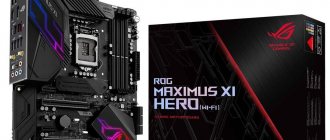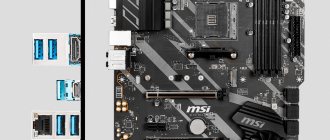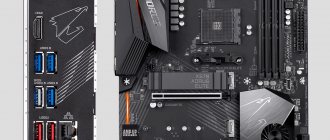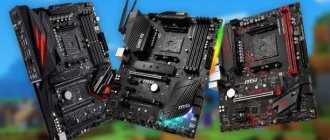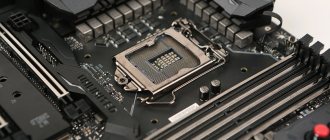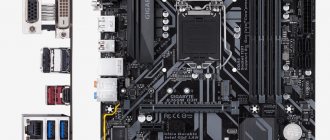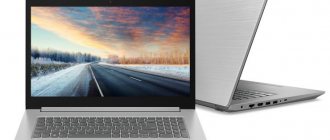Appearance and equipment
We evaluate the design and contents of the packaging.
All three motherboards are made of expensive and hard PCB. As a result, they do not walk around during installation. The product from Gigabyte differs in that the buyer does not need to install the connector protection themselves - it is already in place. It is impossible not to note the slot for the video card, which is reinforced here. As for the package, it includes a sticker, a pair of SATA cables, a disk with drivers, an adapter for the front panel of the case and all sorts of paper documentation. Some buyers will be confused by the lack of a seal or seal on the antistatic bag - it is sealed with regular tape. This may initially make you feel like you're getting a refund.
If we talk about the product from MSI, then this is the best choice for a gamer whose system unit has a transparent window. Yes, this motherboard also does not have RGB backlighting, but it still attracts attention due to its red and black color scheme. The device also stands out due to its huge radiators, which can come in handy during overclocking. The manufacturer also decided to provide the video card connector with a metal frame. Included with this model, the buyer will receive clear instructions for installing the board and processor itself, a disk with drivers, protection for the connectors (painted black and has a proprietary design), a sticker, a bolt for attaching an M.2 SSD and a pair of SATA wires.
The motherboard from Asus looks no less impressive. Unlike its competitors, it boasts AURA Sync LED backlighting. In this case, the user can additionally connect a pair of LED strips - the manufacturer has not forgotten the corresponding pads (as is the case with the MSI product). The massive protective casing above the interface panel also stands out here. Another feature is the DIMM slots, which have latches on only one side, making it easy to install and replace RAM. It remains to add that ASUS TUF B450-PRO Gaming comes with stickers, paper documentation, a disk with drivers, a set of mounting screws for SSD drives, an interface panel cover and two SATA cables.
Ratings
MSI: 4.8, ASUS: 4.8, Gigabyte: 4.7
Memory
How fast RAM do the boards support?
All boards support DDR4 RAM. They all use four slots. However, the minimum permissible frequency for MSI is different: it is 1866 MHz. But if you are building a computer for gaming, then the upper limit is important. In this regard, MSI also wins, since the product from this manufacturer officially supports memory operating at 4133 MHz. The outsider is the board from Asus. However, many of our readers do not expect to get more than 3533 MHz from RAM.
| Name | Max. volume | Memory type | Number of slots | Max. frequency |
| Gigabyte B550 AORUS Elite V2 | 128 GB | DDR4 | 4 | 4000 MHz |
| MSI B450 Gaming Plus MAX | 64 GB | DDR4 | 4 | 4133 MHz |
| ASUS TUF B450-PRO Gaming | 64 GB | DDR4 | 4 | 3533 MHz |
Interestingly, the two boards are maximally capable of interacting with 64 GB of memory, while the Gigabyte B550 Aurus Elite V2 supports 128 GB. Whether you need such a volume is another question.
Ratings
MSI: 4.8, Gigabyte: 4.7, ASUS: 4.6
Gigabyte B550 AORUS Elite V2
Large number of PCI Express x16 slots
One of the few motherboards in this price segment that has three PCI Express x16 connectors, used to connect video cards and other high-performance components.
Drive controllers
Let's get acquainted with the number of internal connectors for connecting storage devices.
SATA connectors are used for connecting hard drives. Their number is six, and only the board from Gigabyte has only four sockets. This immediately makes it a worse choice if you have a large number of drives that interact with just such a connector.
| Name | SATA 6Gb/s | Qty M.2 |
| Gigabyte B550 AORUS Elite V2 | 4 things. | 2 pcs. |
| MSI B450 Gaming Plus MAX | 6 pcs. | 1 PC. |
| ASUS TUF B450-PRO Gaming | 6 pcs. | 2 pcs. |
A gaming motherboard could not do without a slot for an M.2 SSD drive. Moreover, products from Gigabyte and Asus have two such connectors! In the case of the first board, one of the slots is even covered with a heatsink, which allows you to achieve stable speed performance even from a relatively inexpensive drive.
Ratings
ASUS: 4.9, Gigabyte: 4.7, MSI: 4.7
Gigabyte B360M AORUS GAMING 3
The middle segment of Intel boards (B360 and H370 chipsets) still does not offer us overclocking, but they provide much greater expansion opportunities.
Gigabyte B360M AORUS GAMING 3 boasts, among other things, cFossSpeed networking, a reinforced PCIe x16 slot, improved audio, a Wi-Fi connection slot, two M.2 connectors, support for Intel Optane memory, RGB Fusion lighting and, finally, software providing XSplit Gamecaster for streaming games.
Specifications Gigabyte B360M
- Socket: LGA 1151
- Chipset: Intel B360
- Integrated Graphics Support: Yes
- DDR4 RAM (dual channel) slot: 4 pcs.
- PCIe x16 slots: 2 pcs.
- SATA III ports (6 Gbps): 6 pcs.
- USB 3.0 (rear): 5 (3)
- Format: mATX.
Expansion slots
We estimate the number of connectors for a video card and other similar components
It’s not for nothing that a motherboard from Gigabyte costs a little more than others. It is the only one that supports the PCI Express 4.0 standard. This means that this model has better throughput. It will squeeze all the juice out of absolutely any video card, even if it is a GeForce RTX 3090. This board also has three PCI-E x16 slots, and not two, as is the case with its competitors. It is clear that when they work simultaneously, the speed will be reduced, but the very fact of their presence is important!
| Name | Qty PCI - E x 16 | Qty PCI - E x 1 | PCI-E x16 version |
| Gigabyte B550 AORUS Elite V2 | 3 pcs. | 1 PC. | 4.0 |
| MSI B450 Gaming Plus MAX | 2 pcs. | 4 things. | 3.0 |
| ASUS TUF B450-PRO Gaming | 2 pcs. | 3 pcs. | 3.0 |
Of course, the manufacturer had to reduce the number of PCI-E x1 - Gigabyte uses only one such slot. In this regard, MSI is far superior to its competitor. But you need to understand that now such connectors are used less and less. Especially in gaming PCs, where high data transfer speeds are important.
Ratings
Gigabyte: 4.8, MSI: 4.7, ASUS: 4.6
MSI B450 Gaming Plus MAX
High clock speed memory support
The motherboard allows the use of RAM operating at frequencies up to 4133 MHz.
MSI MPG Z390 Gaming Plus
The MSI MPG Z390 Gaming Plus is a good motherboard for a gaming PC with the (so far) best Z390 chipset.
Allows you to overclock the processor and RAM - so if you are interested in buying an 8th or 9th generation Intel Core processor, this model is worth paying attention to.
Specifications MSI MPG Z390 Gaming Plus
- Socket: LGA 1151
- Chipset: Intel Z390
- Integrated Graphics Support: Yes
- DDR4 RAM (dual channel) slot: 4 pcs.
- PCIe x16 slots: 2 pcs.
- SATA III ports (6 Gbps): 6 pcs.
- USB 3.0 (rear): 6 (2)
- Format: ATX.
Interface panel and internal USB connectors
What kind of connectors does the rear side have
? It’s unlikely that anyone will argue with the fact that any motherboard is used not only for games. Therefore, it is important to get a product that has the largest number of connectors on its back panel. And so that many of them turn out to be high-speed. In this regard, Gigabyte looks much more interesting. But in reality, even the least expensive MSI product should suit the vast majority of our readers.
| Name | USB 2.0 | USB 3.2 | USB 3.2 Type-C | Audio | PS/2 | LAN |
| Gigabyte B550 AORUS Elite V2 | 2 pcs. | 5 pieces. | — | 5 pcs., optical output | — | 2500 Mbit/s |
| MSI B450 Gaming Plus MAX | 2 pcs. | 4 things. | — | 6 pcs. | 1 PC. | 1000 Mbit/s |
| ASUS TUF B450-PRO Gaming | 2 pcs. | 4 things. | 1 PC. | 3 pcs. | 1 PC. | 1000 Mbit/s |
If we talk about the audio component, the boards use different audio adapter chipsets, but they all support 7.1. At the same time, connecting multi-channel acoustics to the ASUS board will be difficult, since it uses only three analog connectors and does not have a digital port at all. But the product from Gigabyte is equipped with an optical output. It also received five analog connectors. And one more is built into the MSI board, but it does not have a digital port.
Another important difference between the more expensive Gigabyte B550 and its competitors is the LAN port. Its speed reaches 2.5 Gbit/s, while when purchasing the other two boards you will have to count on the standard 1 Gbit/s. The models we selected do not have wireless modules.
| Name | USB 2.0 | USB 3.2 | USB 3.2 Type-C |
| Gigabyte B550 AORUS Elite V2 | 4 things. | 2 pcs. | 1 PC. |
| MSI B450 Gaming Plus MAX | 4 things. | 2 pcs. | — |
| ASUS TUF B450-PRO Gaming | 4 things. | 2 pcs. | — |
When purchasing a gaming motherboard, you will have to rack your brains about which case to choose. The fact is that all three models support connecting a large number of external USB connectors, and many of them can be high-speed. The table above will tell you more about this.
Ratings
Gigabyte: 4.9, MSI: 4.6, ASUS: 4.6
AMD has banned ASUS from comparing its motherboards with MSI and Gigabyte motherboards
ASUS has published a series of rather entertaining marketing slides in which it compares its AMD X570 chipset-based motherboards with motherboards based on the same chipset from MSI and Gigabyte.
But before we begin to analyze what ASUS presents in these slides, I would like to talk about what happened almost immediately after their publication. What happened was that MSI and Gigabyte didn't like their products being portrayed in a negative light, so they turned to AMD to influence ASUS. ASUS will make these slides disappear from the Internet. However, nothing disappears so easily from the Internet.
Therefore, let's begin the analysis. ASUS indicates that its boards have the best characteristics. Thus, they have power subsystems with a larger number of phases and a better element base, and they are made on printed circuit boards with a larger number of layers. ASUS also claims that its boards support faster memory, have more expansion slots, more USB ports, and have a number of other positive features.
Due to the larger number of phases and better components, the power subsystem of ASUS motherboards heats up less than that of competitors' products. On mid-segment boards, the temperature difference between the power elements of the power supply circuits ranges from approximately 35 °C to almost 50 °C when working with a “16-core Ryzen processor”. Also, the printed circuit board itself, due to the larger number of layers, heats up 15–20 °C less.
ASUS flagship motherboards also boast lower power circuit temperatures. When overclocking the Ryzen 9 3950X processor, the temperature difference between the power elements on the ASUS ROG Chrosshair VIII Hero and Gigabyte X570 Aorus Master boards exceeded 20 °C. In the case of the ROG Chrosshair VIII Formula, X570 Aorus Xtreme and MSI MEG X570 Godlike boards, the difference is not so big - 5-8 °C.
And as a result of higher quality and less hot power subsystems - better overclocking potential. For example, ASUS claims that on its Prime X570-P board it was possible to overclock the “16-core Ryzen 3000” to 3.8 GHz across all cores, while the Gigabyte X570 Gaming X board provided only 3.5 GHz, and the MSI X570-A Pro - only 3.1 GHz. In the case of older solutions, ASUS motherboards are also noted to have better overclocking capabilities: they achieve higher frequencies and provide better operating stability.
In the end, we would like to note that all of these are just marketing materials, and accordingly they may not always correspond to the truth. In addition, do not forget about the different costs of the compared products. However, they are quite interesting to study, and therefore all the slides can be found at this link.
Additional features
How else do the boards differ from each other?
All three boards allow overclocking, but Gigabyte's to the least extent. This is evidenced by the power system chosen by the manufacturer and the corresponding settings hidden too far in the Bios. It's worth trying only if the installed processor consists of four or six cores. Another limitation of this model is the limited number of connectors for case fans.
The MSI board uses a 7-phase power supply system. The buyer should also be pleased with the Flash BIOS button, thanks to which a quick update to the latest BIOS version is carried out (as long as it is pre-loaded onto a connected USB flash drive).
The product from ASUS also has good overclocking capabilities. But we have already mentioned all the main features of this board - otherwise it is no different from competitors with the same price tag.
Ratings
MSI: 4.2, Gigabyte: 4.1, ASUS: 4.0
ASUS TUF B450-PRO Gaming
Branded lighting
The board allows you to synchronize RGB lighting with other peripherals created by the same company.
Types of Asus motherboards
Modern motherboards are classified depending on the form factor:
- ATX . This format is universal for a board that is suitable for literally any user - from beginners to professionals. This board can be used both on desktop personal computers and on server computers.
- Mini ATX . The Mini ATX motherboard has the same set of functional characteristics as the ATX, only it is slightly smaller in size. Its standard is designed for 6 additional devices.
- Micro ATX . The Micro ATX form factor involves installing the board in a Mini-tower case. It is best to use this model on desktop computers.
- Flex ATX . Also intended for home and office use. These boards are cheaper than all of the above, making them the most budget-friendly option.
- NLX . The NLX standard requires installation of this board in a Mini-tower. It should be noted that it is easy to use, thanks to which there are no difficulties in installing or disconnecting any elements of the board.
Price
Motherboards do not have the same price tag.
The least sellers ask for a product from MSI. This is one of the most affordable gaming motherboards. This must be why it doesn’t have the largest number of features that would set it apart from other top models. But sometimes price decides almost everything.
ASUS products always have a certain markup. So the motherboard we reviewed is a little more expensive than it should be. Especially considering that in the future its owner may also need a sound card (to connect multi-channel acoustics). Well, the most expensive on our list is the Gigabyte B550 AORUS Elite V2. This is understandable, because the board has a number of distinctive features. Perhaps the only thing it lacks are Wi-Fi and Bluetooth modules - for that kind of money I would like to get them too.
| Name | average price |
| Gigabyte B550 AORUS Elite V2 | 10,500 rub. |
| MSI B450 Gaming Plus MAX | 8,000 rub. |
| ASUS TUF B450-PRO Gaming | 9,500 rub. |
Ratings
MSI: 4.7, ASUS: 4.6, Gigabyte: 4.4
Which motherboard is better - Asus, MSI or Gigabyte
Currently, the motherboard market is replete with its developers.
In terms of functionality, there are practically no differences between different motherboards built on the same chipset.
In most respects, motherboards from Asus win, although they cost almost 20–30% more (with similar functionality, chipset, socket).
Gamers also prefer components from this manufacturer. But Gigabyte is a leader among buyers whose goal is to build the most budget-friendly PC for home use.
MSI uses "server-grade PCB design" for reliability and durability, as well as 30% improved signal transmission efficiency.

